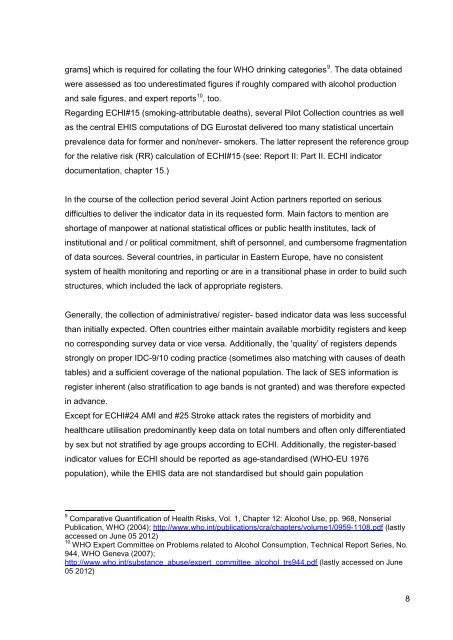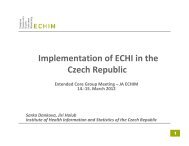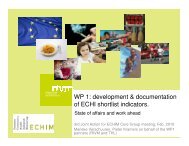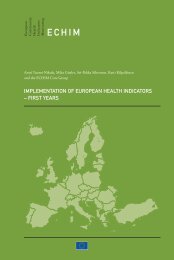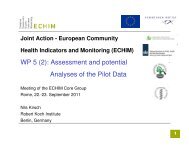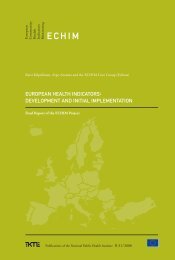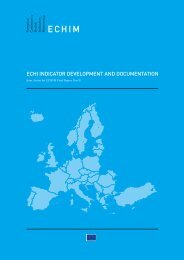Final Report Part III ECHIM Pilot Data Collection Analyses and Dissemination
Part III: ECHIM Pilot Data Collection, Analyses and Dissemination
Part III: ECHIM Pilot Data Collection, Analyses and Dissemination
- No tags were found...
Create successful ePaper yourself
Turn your PDF publications into a flip-book with our unique Google optimized e-Paper software.
grams] which is required for collating the four WHO drinking categories 9 . The data obtained<br />
were assessed as too underestimated figures if roughly compared with alcohol production<br />
<strong>and</strong> sale figures, <strong>and</strong> expert reports 10 , too.<br />
Regarding ECHI#15 (smoking-attributable deaths), several <strong>Pilot</strong> <strong>Collection</strong> countries as well<br />
as the central EHIS computations of DG Eurostat delivered too many statistical uncertain<br />
prevalence data for former <strong>and</strong> non/never- smokers. The latter represent the reference group<br />
for the relative risk (RR) calculation of ECHI#15 (see: <strong>Report</strong> II: <strong>Part</strong> II. ECHI indicator<br />
documentation, chapter 15.)<br />
In the course of the collection period several Joint Action partners reported on serious<br />
difficulties to deliver the indicator data in its requested form. Main factors to mention are<br />
shortage of manpower at national statistical offices or public health institutes, lack of<br />
institutional <strong>and</strong> / or political commitment, shift of personnel, <strong>and</strong> cumbersome fragmentation<br />
of data sources. Several countries, in particular in Eastern Europe, have no consistent<br />
system of health monitoring <strong>and</strong> reporting or are in a transitional phase in order to build such<br />
structures, which included the lack of appropriate registers.<br />
Generally, the collection of administrative/ register- based indicator data was less successful<br />
than initially expected. Often countries either maintain available morbidity registers <strong>and</strong> keep<br />
no corresponding survey data or vice versa. Additionally, the 'quality’ of registers depends<br />
strongly on proper IDC-9/10 coding practice (sometimes also matching with causes of death<br />
tables) <strong>and</strong> a sufficient coverage of the national population. The lack of SES information is<br />
register inherent (also stratification to age b<strong>and</strong>s is not granted) <strong>and</strong> was therefore expected<br />
in advance.<br />
Except for ECHI#24 AMI <strong>and</strong> #25 Stroke attack rates the registers of morbidity <strong>and</strong><br />
healthcare utilisation predominantly keep data on total numbers <strong>and</strong> often only differentiated<br />
by sex but not stratified by age groups according to ECHI. Additionally, the register-based<br />
indicator values for ECHI should be reported as age-st<strong>and</strong>ardised (WHO-EU 1976<br />
population), while the EHIS data are not st<strong>and</strong>ardised but should gain population<br />
9 Comparative Quantification of Health Risks, Vol. 1, Chapter 12: Alcohol Use, pp. 968, Nonserial<br />
Publication, WHO (2004); http://www.who.int/publications/cra/chapters/volume1/0959-1108.pdf (lastly<br />
accessed on June 05 2012)<br />
10 WHO Expert Committee on Problems related to Alcohol Consumption, Technical <strong>Report</strong> Series, No.<br />
944, WHO Geneva (2007);<br />
http://www.who.int/substance_abuse/expert_committee_alcohol_trs944.pdf (lastly accessed on June<br />
05 2012)<br />
8


